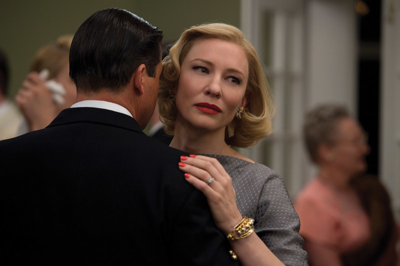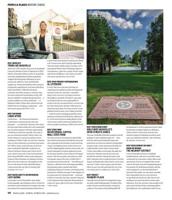The other night I decided to rewatch my two favorite movies this year — two movies that couldn't be more different, except for the love I feel for them. Mad Max: Fury Road is all maximalist gestures, painted in a palette of rust, dust, fireballs and speed — a motorpsycho hellscape out of Springsteen's "Born to Run," monster drums and electric guitar included. Yet beholding the mastery, kinetic panache and, yeah, beauty that George Miller marshals from that chaos is like watching a conductor coax Mahler from an orchestra of air-raid sirens.
Carol is quiet where Fury Road is loud, restrained where Fury Road is orgiastic, anchored in a recent past of suburban comfort where Fury Road cruises a dystopian futuristic desert. What the two movies share — besides a long road journey, and starting by following a male character who yields to a female protagonist — is uncommon command of the medium. Control isn't just the formal rigor that Carol exhibits from the very first scene: It's the stifling exactitude required of its two main characters, whose every public utterance and gesture must be delivered in code.
The movie establishes that as soon as a man walks into a 1950s hotel restaurant and glibly shouts to a young woman across the room. It will take roughly another hour-and-a-half to learn why the woman and her dining companion react to his arrival with expressions a more attentive man might read as alarm. The women part, not in any way the man might notice; only we register the extra beat the elegant older woman leaves her hand on her tablemate's shoulder, and the slight nod of the head that acknowledges it.
From there Carol goes back in time, retracing the steps that led shopgirl Therese (Rooney Mara) and upper-crust wife and mother Carol Aird (Cate Blanchett) to lock eyes across a department-store display of perfect dolls and a toy-train utopia. It's as immaculate as the home Carol shares with her husband Harge (Kyle Chandler, a walking bruise of wounded masculine pride) and preteen daughter; yet Carol's every interaction with him seethes with desperation and longing for escape. The rest of the movie is what happens when Carol falls in love with Therese and tries to get away with her, only to learn it isn't enough just to stay secret in public.
The director, Todd Haynes, made the Julianne Moore melodrama Far From Heaven, a fascinating experiment that played like a semiotician's painstaking re-creation of Douglas Sirk's brazen Technicolor weepies. It was an affecting movie, but every element of Sirk's style, from the saturated colors to the use of mirrors, still left a vapor trail of quotation-marked pastiche. Not Carol. Maybe his Mildred Pierce HBO miniseries served as practice, but Haynes' measurement of every hand gesture, every isolating frame within the frame, every glance or line charged with hidden meaning, has a precision that obliterates air quotes. Far From Heaven's interracial romance seemed itself something of a code as it pushed a subplot about Dennis Quaid's closeted husband off to the sides; Carol, adapted from an initially pseudonymous 1952 novel by the late Patricia Highsmith, is painfully direct about the stakes facing its lesbian heroines, who stand to lose children and homes if they drop their cover in a restaurant — or in their own bedroom.
The tension is keenly felt in Blanchett's exquisitely modulated performance. Pressed to maintain a public façade, Carol is different people as the occasion demands: a doting mom, a coolly poised wife at social functions, a huskily voiced seducer with Therese. The law and social strictures demand that these be exclusive, with Carol's friend and former lover Abby (Sarah Paulson, making explicit what was implicit in the true-blue Eve Arden gal-pal role) standing as proof of what comes to those who step outside. As the less experienced Therese, Mara has an open face that seems to be processing several contradictory things simultaneously — the opposite of Carol, who must be one thing at a time.
The lush atmosphere Haynes creates around them with his excellent cinematographer, Ed Lachman, isn't as sterile as the germophobic bubble world of his 1995 classic Safe, but it's very nearly as tense. The screenwriter, Phyllis Nagy, a filmmaker and friend of Highsmith's who shepherded the project for more than two decades and through myriad production setbacks, supplies a taut script that occasionally echoes Brief Encounter, even Lolita. It's smart enough to hand the hat-tipping statement to a minor character — the difference between what people say in movies and what they really feel — then to play it almost off-handedly. Sharper still (and masterfully delivered by Blanchett) is the gulf of heartbreak between Carol's two variations of her two-word refrain: "That's that."
Given the times and the situation, Carol seems headed for the requisite misery that marked (and marred) fiction about gay characters for decades. But gay readers loved Highsmith's novel back in the day because it ultimately had no patience for that well-of-loneliness jive, and neither does Haynes' film. Carol may begin in public with an interrogative, but it ends in public with a declarative all the more dramatic for not being voiced, conveyed with all the passion the minor chords in Carter Burwell's gloriously tormented score can muster. And that's another difference between my two favorite movies this year. Mad Max: Fury Road concludes with the promise of further exploits in its obsessively detailed wasteland — but it's Carol that ends with the advent of a whole new world.
Email arts@nashvillescene.com





